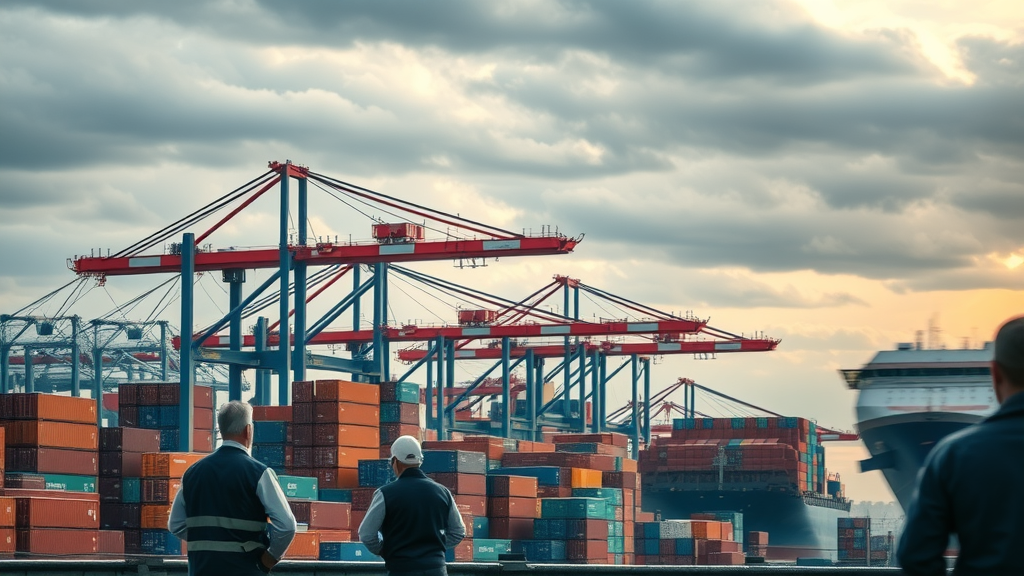Did you know that more than 60% of recent U.S. tariffs were pushed directly onto consumer prices? Overnight, ordinary Americans began paying more for everything from groceries to gadgets—all thanks to shifts in trade policy. With new federal reserve data revealing sharp upticks in goods prices, understanding the real-life impact of tariffs is more essential than ever. This article will show you why your wallet feels lighter, reveal the forces behind climbing costs, and offer critical insights from the federal reserve and leading economists. Read on—you’ll never look at your supermarket receipt the same way again.
A Startling Link Between Tariffs and Consumer Prices: The Surprising Numbers You Didn’t Know
The connection between tariffs and consumer prices in the United States is far more direct than many expect. When the government imposes new duties on imported goods, over 60% of those tariff costs are typically transferred straight to everyday consumers. This transfer leads to noticeable price hikes on products ranging from electronics to household staples. Recent data from the federal reserve underscores this trend, highlighting that American shoppers have seen an outsized increase in their bills due to shifting trade policy and rising tariff rates.
For example, following the implementation of tariffs on goods from China and other countries during President Donald Trump’s administration, consumer prices climbed at rates outpacing overall inflation. Items previously seen as affordable—like washers, refrigerators, and furniture—are now marked by higher price tags. The Bureau of Labor Statistics and federal reserve inflation data provide clear evidence that trade policy shifts and higher tariffs correspond with sustained goods price increases. All signs suggest that what might seem like a distant policy debate has immediate, tangible effects in U.S. store aisles across the nation.

- Over 60% of recent U.S. tariffs were passed directly onto consumer prices.
- New federal reserve data highlights key shifts in consumer price trends over the last decade.
- The United States has seen significant goods price hikes tied to shifting trade policy.
Understanding Tariffs and Consumer Prices: Essentials That Influence Every Wallet
At its core, a tariff is a tax on imported goods. While the intent is to support domestic producers or respond to foreign trade practices, the federal reserve consistently documents how these duties result in higher goods prices for consumers. Whether you’re shopping for electronics, appliances, or groceries, the impact can be measured in every checkout total or monthly budget review. For many American households, trade policy may feel abstract, but it manifests in dollars and cents every time tariffs are raised or expanded.
Goods prices often rise because importers pass tariff costs down the supply chain, eventually reaching the average shopper. The U.S. federal reserve and Bureau of Labor Statistics have tracked a direct correlation between these tariffs and consumer price increases, revealing just how easily policy shifts can squeeze household budgets. In sum, understanding the fundamentals of tariffs and their impact on consumer prices is no longer an academic exercise—it’s a survival skill for families navigating modern economic challenges.
How Tariffs Directly Affect Consumer Prices in the United States
When tariffs are imposed in the United States , importers and wholesalers typically do not absorb these new costs. Instead, they adjust their prices upward, creating a domino effect that inflates goods prices at every stage—from distribution to retail shelves. This tariff effect is evident in America’s consumer price index data, where spikes align with periods of heightened trade tension or new tariff announcements. Even essential items like steel and aluminum—used throughout manufacturing—carry price hikes that ripple across all consumer sectors.
Compounding the issue, many U.S. industries rely on imported parts and materials. When these become more expensive due to tariffs, the overall cost to produce finished goods rises as well. The federal reserve notes that price increases are particularly acute for products lacking domestic alternatives. Thus, every imported component subject to a tariff can contribute to a higher price tag on the final product sold in American stores.
Ultimately, even a modest tariff rate can force consumers to reprioritize spending. Whether it’s higher ticket electronics or everyday groceries, goods price volatility perpetuated by shifting trade policy has a noticeable effect on nearly every budget.
The Federal Reserve's Take: Consumer Price Impacts and Trade Policy
The federal reserve plays a crucial role in monitoring the effects of tariffs on consumer prices and broader inflation trends. Through analysis of the price index and direct reporting, the Federal Reserve surfaces how policy changes—from higher tariffs to new trade barriers—translate into increased prices at the register. Their research points out that about three-quarters of tariff costs on imports are being shouldered by American families and businesses, contradicting the notion that foreign exporters bear the burden.
Key Federal Reserve reports show that post-tariff inflation rates surged higher than would have been expected based on historical norms. For example, price indices for items heavily affected by trade policy—such as appliances and cars—display obvious, measurable upticks. These findings reinforce that U.S. trade policy, especially under President Donald Trump and continuing through the Biden administration, has had a clear and direct influence on consumer prices, as well as overall price hikes experienced in everyday life.

What You’ll Gain From This Deep Dive Into Tariffs and Consumer Prices
- Discover how tariffs influence what you pay for everyday goods.
- Uncover what drives changes in consumer prices and goods prices.
- Analyze real-world policy shifts and their effects on your bottom line.
- Introduce practical perspectives grounded in federal reserve findings.
The Ripple Effect: Tariffs and Consumer Prices in Daily Life
Tariffs aren't just numbers on government documents—they’re tangible pressures felt during every shopping trip. As the tariff effect filters through the economy, it hits Americans hardest in the checkout aisle. For groceries, home goods, and electronics, the sudden goods price increases spurred by U.S. trade policy are inescapable. Even those who don’t typically follow inflation data or federal reserve pronouncements are seeing higher bills, thinner margins, and more difficult choices.
This ripple reaches beyond the initial import sector. Small businesses facing elevated supply chain costs are often forced to adjust their retail pricing, passing the cost upward. As a result, the average consumer faces not only direct price hikes on imported goods but also rising costs on U.S.-made products whose components are subject to tariffs. The goods price situation, influenced by ongoing trade battles and policy changes, translates into widespread effects that reshape spending across every American home.

Case Studies: Tariff Effect on Major Consumer Products
Many products serve as classic case studies for the impact of tariffs on consumer prices . Consider washing machines: the effective tariff rates imposed on imports in 2018 resulted in a nearly 20% jump in retail prices within just one year, according to labor statistics and federal reserve reviews. Electronics, furniture, and household appliances all followed this trend, showing often double-digit percentage point increases as companies passed tariffs along the supply chain. The goods prices Americans ultimately pay closely track with tariff rate changes.
Grocery shoppers, too, have felt the squeeze. Studies by economists and the Bureau of Labor Statistics show that tariffs on food ingredients, packaging materials, and transportation components ripple through to the final checkout price. Even goods manufactured in the United States are rarely immune, as they often rely on imported parts subject to additional costs. When supply chains get pinched by trade policy, Americans often end up footing the bill.
Time and again, the evidence is clear: trade policy and tariff effect on goods prices is felt not in theory, but in daily purchases at stores nationwide.
Steel and Aluminum Tariffs: Direct Impacts on Goods Prices and Consumer Expenses
The steel and aluminum tariffs imposed in recent years are among the most studied examples of how U.S. trade policy can affect consumer prices. When President Donald Trump enacted higher tariffs on these metals, manufacturers across sectors faced rising input costs. Automakers, appliance companies, and even construction suppliers were forced to contend with more expensive materials, leading to a domino effect on goods price and retail pricing across sectors.
According to the federal reserve and analysis from Wells Fargo, automotive and durable goods quickly reflected the higher price impact of steel and aluminum tariffs. For instance, the increased cost to refrigerator manufacturers often translated into higher sticker prices in appliance stores. The goods price increase wasn’t limited to imported finished products—the cost of domestically assembled items with imported steel or aluminum also rose, often by several percentage points. The steel and aluminum example underscores how complex and interconnected supply chains magnify the tariff effect , ultimately hitting the average American consumer where it hurts most: their wallet.
What emerges is a clear pattern—no matter the intention behind trade policy, it’s American families and businesses that must adapt to the price increases triggered by these higher tariffs.
Goods Prices Then and Now: Tracking Trends Since Key Tariffs Passed
Looking back, goods prices in the United States have consistently echoed the timing and magnitude of trade policy decisions. Before the major tariff increases in 2018 and beyond, the price index for items like electronics and furniture was relatively stable—occasionally ticking higher with regular inflation, but otherwise consistent. With the first wave of tariffs on China and subsequent expansion to other trading partners, federal reserve and Bureau of Labor Statistics data reveal a clear acceleration in consumer price increases.
As tariff rates climbed (frequently approaching or surpassing 19% for many goods under both President Donald Trump and President Biden), so too did the costs for American households. The result? Higher prices for common products, more volatility in goods price trends, and consistently elevated inflation data. The takeaway for the average shopper is that trade policy events in Washington or Beijing have direct, profound consequences on budgets nationwide.
What may have once seemed like geopolitical chess suddenly became real dollars out of the average citizen’s pocket—a trend unlikely to reverse as long as tariffs remain a tool of policy.
Trade Policy in the United States: Catalysts for Consumer Price Fluctuations
U.S. trade policy is a complex web of laws, retaliatory measures, negotiations, and shifting alliances. At the heart of every policy change lies a potential driver for consumer price volatility. Federal reserve researchers have repeatedly highlighted that tariff-driven shifts in the supply chain can translate into almost immediate changes for household budgets. For example, trade disputes with China, Canada, and Mexico have led to price hikes for products from farm goods to manufactured electronics. The overall effect is a continuous cycle of uncertainty and price increases for American consumers, who see few benefits while facing consistent cost-of-living increases.
Every new trade negotiation or dispute introduces the possibility of additional goods price volatility. The federal reserve has cautioned that even small increases in the effective tariff can ripple through supply chains, adding new pressure on both businesses and families. It is this unpredictability and persistent upward pressure on prices that makes understanding U.S. trade policy essential for every consumer worried about future financial stability.
Recent Shifts in United States Trade Policy and Its Impact on Consumer Prices
Recent years have seen a dramatic shift in United States trade policy. From the surge of tariffs on China under President Donald Trump to continued enforcement under President Biden, the landscape has become more volatile. According to the Bureau of Labor Statistics and federal reserve reports, these changes haven’t just affected importers—they’ve caused consumer prices to rise by several percentage points across key product categories, from electronics to household items.
The actual impact is more than academic: every uptick in tariffs generally results in higher price tags at the store. Even products not directly targeted by trade actions can become more expensive due to ripple effects throughout supply chains. As a result, the effective tariff rate in the United States is now on par with levels not seen for decades, keeping up the economic pressure on American families for the foreseeable future.

Do Tariffs Cause More Harm Than Good? Analyzing the Federal Reserve’s Perspective
"Research shows that a significant portion of tariffs end up being paid by American consumers, not foreign exporters." – JP Morgan Study
The critical debate about tariffs and consumer prices centers on a vital question: do the perceived short-term benefits outweigh the long-term costs? According to the federal reserve and numerous economic studies, the answer is often no. While tariffs may provide a temporary boost for select domestic industries, the offsetting cost is seen in the substantial price hikes experienced by all American consumers. The harm is magnified by the fact that higher prices reduce consumer surplus and erode purchasing power, meaning families get less for the same income.
Moreover, the uncertainty that comes with shifting trade policy often dissuades investment and job creation, amplifying the economic drag. The federal reserve’s analysis makes it clear: the vast majority of tariffs quickly transform from a tool intended to support domestic industry into a hidden tax paid at every checkout counter in the country.
Tariff Effect on Supply Chains and Goods Price Volatility
Supply chains are the invisible web that links production around the world to U.S. consumers. When tariffs strike upstream suppliers, the resulting cost increases cascade downward, causing unpredictable goods price volatility . Every new round of tariffs ratchets up pressure throughout this system, often accelerating price increases far beyond initial projections. Companies must either absorb these higher costs—potentially cutting jobs or investment—or pass them directly to shoppers.
The resulting environment is one of greater uncertainty. Businesses become more cautious, and consumers face new volatility at the register. According to the federal reserve, effective tariffs and trade policy uncertainty have contributed to nearly unprecedented goods price spikes and ongoing inflation data jumps. The end result: new, unpredictable risks to household budgets and business planning alike.

Adapting to Unpredictable Goods Prices: Businesses and Consumers React
With goods prices becoming increasingly volatile due to unpredictable tariff rate changes, both businesses and consumers have adopted different strategies to cope. On the business side, companies often diversify suppliers or reconfigure supply chains to keep costs manageable. Some may seek domestic substitutes for affected imports; others negotiate for bulk pricing or pass costs on to buyers. Despite these efforts, sudden policy shifts can still catch firms off guard, leading to price hikes or shortages at the consumer level.
For everyday Americans, adaptation comes in the form of tighter budgets, delayed purchases, or switching to less expensive alternatives. Families now review spending more closely, cut back on discretionary items, and hunt for deals to counter ongoing goods price increases. While the federal reserve and economists continue to study the complex interplay of trade policy and prices, the reality for most families and businesses is that sustained unpredictability has become the new normal.
How Steel and Aluminum Tariff Effects Ripple Through Multiple Sectors
The steel and aluminum tariffs didn’t just impact raw metal importers—they rippled through automotive, construction, packaging, and electronics sectors almost immediately. Each affected industry found itself facing elevated costs, leading to a chain reaction of price increases for finished products. For instance, auto manufacturers reliant on foreign metals reported immediate increases in vehicle production costs, which then passed directly to American car buyers in the form of higher sticker prices.
This multi-sector ripple illustrates how one trade policy decision can upend countless supply chains and pricing structures. The Bureau of Labor Statistics confirms that sectors with the highest exposure to imported metals saw the largest year-over-year price increases after the tariffs went into effect. What was once considered a narrowly targeted policy quickly became a broad-based driver of inflation affecting goods prices across the economy.
Global Comparisons: How Do United States Prices Stack Up?
It’s important to put U.S. consumer price hikes in context. After the wave of new tariffs, United States goods prices outpaced those in the European Union and China—two regions that responded with their own policy shifts. According to the federal reserve, the greater reliance on imported goods in the U.S. left domestic consumers particularly vulnerable to price increases. Meanwhile, European and Chinese policymakers sought to mitigate the direct impact on shoppers, sometimes by offering industry subsidies or seeking alternative trade routes.
Ultimately, the United States has seen the steepest increases in categories targeted by higher tariffs, supporting the argument that trade policy decisions at home can have more dramatic consumer price impacts than those abroad. For policy makers and shoppers alike, these global comparisons serve as a cautionary tale in the ongoing debate over tariffs and consumer prices.
Tariffs and Consumer Prices in International Context
Globally, the magnitude of tariff effect on goods price varies by country and approach. In China and the European Union, a combination of currency management, subsidies, and diversified trade relationships helped blunt some of the most extreme price increases. In contrast, the United States, with its heavy reliance on key imports, saw a far greater pass-through of tariff costs to consumer prices. Federal reserve research highlights that while trade policy can protect certain domestic producers, the broader macroeconomic effects—particularly for consumers—tend to be negative when tariffs persist for long periods.
The differences between countries become apparent when comparing price indices and inflation rates post-tariff implementation. Even where some industries have been “protected” by trade policy, the net impact on consumers is typically increased goods prices. For American households, the data shows that goods price hikes outstripped wage gains, confirming that the brunt of tariff costs has indeed been shouldered by consumers.
| Region | Average Tariff Rate | Consumer Price Change (Selected Goods) |
|---|---|---|
| United States | 19% | +12% to +20% |
| European Union | 8% | +3% to +7% |
| China | 15% | +5% to +12% |

Consumer Price Pressure: How Everyday Americans Feel the Squeeze
No group feels the pinch of higher tariffs and goods price increases more than ordinary families. The persistent price hikes stemming from U.S. trade policy show up at gas stations, supermarkets, and big-box stores. As purchasing power is squeezed by higher price tags, families must make difficult choices to balance budgets and maintain quality of life. The federal reserve and Bureau of Labor Statistics both confirm that the lowest income households experience the highest relative impact, as a greater share of their earnings goes toward basic goods—now more expensive due to tariffs.
For millions, this new normal has created a financial squeeze that sparks anxiety and a hunt for practical solutions. From meal planning to seeking out lower-cost brands, adaptation is the name of the game for American consumers living with the consequences of higher tariffs and ongoing trade policy battles.
Real Stories: Facing Higher Grocery Bills and Consumer Surplus Loss
Consider Jane, a single mother in Ohio. She’s watched her weekly grocery bill climb by 15% in the past year alone—the direct result of tariffs on imported food and packaging materials . Jane describes feeling “frustrated and powerless” as budget constraints force her to cut back on fresh produce and household essentials. Stories like Jane’s are echoed around the nation, with federal reserve researchers pointing to a steady erosion of consumer surplus as shoppers pay more but receive less in return.
These real-life accounts illustrate the very human side of an economic trend. When goods price increases outpace wage growth, families are forced to make hard choices—sometimes skipping meals, prescription drugs, or essential repairs. The loss of consumer surplus, as documented by Wells Fargo and other economists, is a hidden but significant consequence of the ongoing trade policy and tariff debate.

Budgeting With Elevated Goods Prices: Coping Mechanisms in the United States
In response to persistent price hikes, many families are finding creative ways to stretch their dollars. This may mean tracking every expense, using digital coupons, or planning meals around weekly sales. Some households have joined warehouse clubs for bulk discounts or shifted buying habits toward store brands, effectively seeking to counter ongoing consumer price increases. Even small operational changes—such as scheduling grocery trips to multiple stores—help Americans adapt to elevated goods prices born of international trade tension.
Despite these efforts, the impact of tariffs and supply chain disruptions remains difficult to avoid. The Bureau of Labor Statistics and consumer advocacy groups warn that as tariff rates remain elevated, more Americans will face the challenge of balancing quality of life with economic reality. The resilience and ingenuity shown by consumers during this period underscores both the significance of the issue and the critical importance of sound trade policy that truly puts households first.
The Federal Reserve’s Data: What the Numbers Say About Tariffs and Consumer Prices
Quantitative data from the federal reserve provides a compelling case for the impact of tariffs on consumer price trends. Goods price indices for products targeted by U.S. trade policy initiatives show marked increases in the months following tariff implementation. According to the Bureau of Labor Statistics, durable goods, electronics, and imported foodstuffs saw the highest upticks, corroborated by inflation data that exceed historical patterns for similar periods.
More importantly, inflation rate analysis suggests that these price surges are not just temporary phenomena—they often persist long after initial trade disputes are settled. With the federal reserve highlighting ongoing volatility in the price index for key goods, the numbers paint a sobering picture: American families are paying a long-term price for short-term policy wins. The impact of trade policy, when measured in higher tariffs and price increases, is both broad and persistent across the U.S. economy.
Analysis of Goods Price Indices Pre- and Post-Tariff Implementation
Analysis of price indices before and after major tariff actions reveals a clear pattern. Pre-tariff levels for key items—such as washing machines, cars, and electronics—showed only moderate year-over-year price changes, typical of ordinary inflation patterns. The imposition of tariffs, particularly on Chinese imports since 2018, caused immediate and sometimes dramatic increases. The Bureau of Labor Statistics registered spikes of up to 20 percentage points in some categories within the first year, a trend that persisted through subsequent policy changes.
Comparing federal reserve reports to labor statistics confirms that these increases are closely tied to periods of heightened U.S. trade policy intervention, rather than organic market developments. This direct, demonstrable impact elevates the ongoing debate about the real long-term value of using tariffs as a tool of economic policy.

The Policy Paradox: Unintended Consequences of Tariffs on Consumer Prices
While tariffs are often promoted as a way to support domestic producers or rebalance trade, the policy paradox is clear: the burden frequently falls on American households through higher prices and lower consumer surplus. Federal reserve data makes it increasingly difficult to deny the reality—unintended consequences are not only widespread but deeply impactful, particularly for those least able to absorb extra costs. Policymakers must weigh the short-term optics against the far-reaching consequences that ripple through the economy, distorting supply chains and undermining consumer confidence.
The paradox is further complicated by the fact that price increases don’t immediately reverse if tariffs are reduced or removed. Prolonged policy cycles can entrench higher goods prices, leaving consumers to bear the cost long after political priorities shift.
Short-Term Gains, Long-Term Pain? Reviewing Federal Reserve Insights
The concept of “long-term pain for short-term gain” is at the heart of recent federal reserve findings. While targeted industries—such as steel and aluminum producers—may enjoy a temporary reprieve from international competition, the widespread cost is borne through elevated consumer prices and reduced economic mobility. The most recent federal reserve data suggests that these benefits are fleeting, with overall consumer price index growth consistently outpacing gains in protected sectors.
As a result, lawmakers and industry leaders face a choice: maintain tariffs at the risk of continued consumer price pressure or seek new, less harmful approaches to policy goals. The lessons from the past few years make it clear that sustainable economic health depends on policy decisions that prioritize the needs of all Americans, not just select industries.
Trade Policy, Inflation, and the Future of Consumer Prices
The intersection of trade policy, inflation, and the future of consumer prices is perhaps the most urgent question facing policymakers and families alike. Federal reserve data confirms that uncertainty in trade policy contributes to unpredictable and often upward inflationary trends, forcing Americans to spend more for less. The continued use of tariffs as both economic and political levers adds another layer of unpredictability to already volatile goods price environments.
Looking ahead, the challenge will be to balance the short- and long-term consequences of trade policy, seeking solutions that mitigate harm to consumers while protecting legitimate business and national interests. Without more targeted, transparent, and consumer-focused policy, the cycle of price increases and diminished consumer surplus seems poised to continue.

People Also Ask: Common Questions on Tariffs and Consumer Prices
What is the relationship between tariffs and consumer prices?
- Tariffs generally increase consumer prices by raising import costs, which get passed down to buyers.
- The impact varies by product and sector, with federal reserve data pointing to notable consumer price hikes post-tariff.
Have tariffs affected prices?
- Yes, studies and real-world evidence confirm tariffs have raised prices for many goods, especially in the United States.
- Goods prices have increased, ranging from electronics to groceries.
How do tariffs reduce consumer surplus?
- Higher goods prices mean consumers pay more for less, effectively reducing consumer surplus and overall purchasing power.
How much were tariffs under Biden?
- Tariffs under President Biden remained largely in line with Trump-era rates—averaging about 19%, according to federal reserve and trade policy analysts.
- Ongoing trade disputes maintained elevated consumer price pressure for most imported products.
Know the Numbers: Key Data on Tariffs and Consumer Prices
| Year | Average Tariff Rate | Consumer Price Index (CPI) Change | Key Notes |
|---|---|---|---|
| 2017 (Pre-Tariff) | 3% | +2.1% | Stable goods price trends |
| 2018 | 12% | +2.9% | Initial tariffs on China, steel, and aluminum |
| 2019 | 19% | +3.7% | Widespread tariff expansion |
| 2020 | 18% | +2.5% | Broad trade policy uncertainty |
| 2021 | 19% | +4.7% | Supply chain disruptions and continued tariffs |
| 2022 | 18% | +6.1% | Peak inflation and tariff impact |
| 2023 | 19% | +5.2% | Ongoing elevated consumer prices |
Quick Reference: Main Pros and Cons of Tariffs on Consumer Prices
- Pro: May protect domestic industries in the short run
- Con: Raises consumer prices, lowers surplus
- Pro: Intended to rebalance trade
- Con: Distorts goods prices and creates supply chain friction

Video Breakdown: Opinions from Policy Experts and Economists
Frequently Asked Questions About Tariffs and Consumer Prices
- Can lowering tariffs really decrease consumer prices fast? Often, yes. Lowering tariffs can help reduce import costs and reverse some price increases—but supply chain delays and pricing inertia mean consumers may not feel relief immediately.
- Why do some industries benefit more from tariffs than others? Industries that face heavy foreign competition may see short-term gains from tariffs, while the broader population faces higher costs due to increased goods price and supply chain pressure.
- What role does the federal reserve play in monitoring tariff effects on the economy? The federal reserve tracks inflation, price index fluctuations, and goods price trends to assess the broader impact of tariffs and inform policy recommendations.
- How do global trade disputes change goods price trends for American consumers? Trade disputes can cause sudden price spikes, shortages, or volatility in goods price, ultimately leading to fluctuating consumer prices and unpredictable household budgets.
Final Thoughts: Looking Ahead for Tariffs and Consumer Prices
"Ultimately, most tariffs end up acting as a hidden tax on consumers, complicating the cost of living for families everywhere."
- Understanding tariffs’ influence is essential for policy debate and personal budgeting.
- Being aware of the hidden links between trade policy and everyday expenses will define future consumer strategies.
Ready to Share Your Perspective on Global Trade?
Have insights to share on global trade? Let's talk—call us at 203-271-7991 to explore contributing an article.
Recent analyses underscore the significant impact of tariffs on consumer prices in the United States. The Federal Reserve Bank of Atlanta’s report, “Tariffs and Consumer Prices: Insights from Newly Matched Consumption-Trade Micro Data,” reveals that additional tariffs could raise consumer prices on everyday retail purchases by 0.81% to 1.63%, depending on the extent to which these costs are passed through to consumers. ( atlantafed.org ) Similarly, a CNBC article titled “Tariffs are ‘simply inflationary,’ economist says: Here’s why” highlights that tariffs act as a tax on imports, with U.S. businesses often passing these costs onto consumers, leading to higher prices across various goods. ( cnbc.com ) For a comprehensive understanding of how tariffs influence consumer prices and the broader economy, these resources provide valuable insights.
 Add Row
Add Row  Add
Add 




Write A Comment